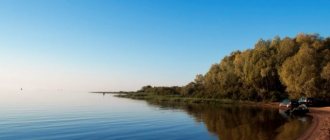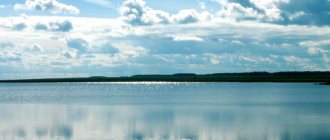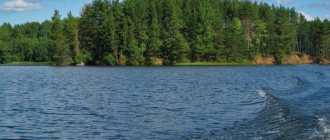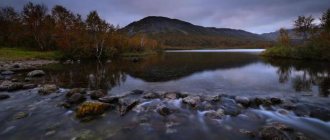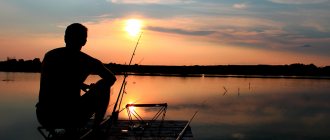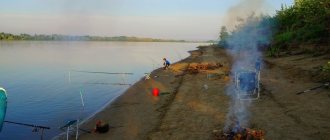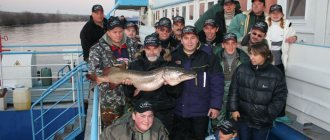What kind of fish is found on Seliger
It is difficult to list the entire list of Seliger fish due to the large number of varieties. Real fishermen do not chase what they get, but go fishing with purpose. The most commonly hunted fish species are:
- Bream is a commercial fish species. From mid-summer, closer to autumn, it is more difficult to catch. The bream goes into the depths. For fishing to be successful, you will need a boat.
- Pike, like all predators, feels like the mistress of the lake. On Seliger it can be caught where there are shallows, snags, and coastal thickets.
- On Seliger you can catch perch weighing up to 1.5 kg. Fish live in almost all places of the lake, but for fishing to be successful, you need to choose the right gear and bait.
- Pike perch can be called the king of Seliger. This is what fans of spinning rods come here to fish for. According to reviews from experienced fishermen, pike perch can be caught weighing up to 1 kg, but there are trophies weighing about 8 kg.
- Burbot is found in great abundance on Seliger, but there is a high chance of catching it in winter. Fish loves cold water, which cools down to the required temperature in November or even December.
- The variety of fish includes chub, trout, bream, eels and other fish species. There are a lot of them in the lake, but it is unwise to purposefully go fishing for them. You can catch large numbers of such fish if you get a bite. In other cases, you will periodically come across different varieties.
In photos posted on the Internet by fishermen, Seliger fish lures fishing enthusiasts in summer and winter. Even if you don’t manage to catch the coveted perch or pike perch, you will always be able to catch a variety of fish on your fish.
Advice! When going fishing with your family, it is wise to bring fishing rods for your children. It will be good fun for them to catch small breams and chubs from the shore.
catching bream in winter on Seliger
Winter bream fishing is a whole encyclopedia in which special baits are intertwined with special additives in complementary foods and numerous other secrets. It is impossible to fully cover the entire topic, and it is not necessary. When building your fishing, it is important to understand specific small moments of fishing, some of which will be discussed.
Teetotal float
The best floats for winter fishing are made from dense foam grade 200 and higher. The softer foam plastic, although slowly but inevitably, begins to “drink” water. As a result, the carrying capacity of the float is reduced, and all the labor-intensive work of adjusting the weight of the sinker (jig) to the float goes down the drain, and this is a shame. However, a float made of not very dense foam plastic can be protected from water by covering it entirely (and not just the top part) with a thick layer of paint, or even better, with several thin layers. The paint, by the way, will play another important role - it will prevent the float from quickly freezing in the cold, disturbing the balance of the equipment. I use a slotted spoon and hit it on the head. The very last thing to do is to make noise on the ice when a bream or large bream approaches. There are usually three types of noise that are negative for fishing, traditionally made by uninformed anglers. The first is drilling additional holes next to the hole(s) where the bite begins to fade. In this case, the flock can simply leave the area, parting with complementary food without regret. The second - after moving to the next baited hole, the angler almost throws a metal box onto the ice and after that tries to catch a bream from this hole.
The third is the most common type of noise, which can also greatly alert the bream, namely, knocking down ice from a skimmer, hitting it with the ice. Of course, in severe frost, the ice on the scoop is a big nuisance, but it is better to remove it by some other, silent method. Or use a scoop made of high-quality plastic - slightly squeezing it with your palm, and the ice will fall off on its own. Live and half-dead bloodworms Bream can also take on a non-living bloodworm, even one that has already slightly died out, but this is not a rule at all. A live, mobile bloodworm causes significantly more bites, especially if you catch it not with a game, but with a float. Therefore, bream fishermen try to get immaculately fresh, mobile bloodworms for fishing. However, in frosts over 10-15 degrees, especially in frosts with strong winds, in order to deprive the bloodworm of its activity, it is enough to hold it in an open box for only ten seconds.
In difficult weather conditions, fishing will be saved by two bloodworms: large and small. The main supply of bloodworms is stored in a large box, and this bloodworm bottle is kept warm, for example, in the inner pocket of a jacket or sheepskin coat. The large bloodworm is taken out only to quickly replenish the working bait, which is stored in the small bloodworm. The bream above the bait Quite often, an interesting picture is observed - the hole is fed, but all the bites of the bream are observed significantly above the bottom. It seems logical to assume that the fish simply does not respond to complementary feeding, but hangs in the water floor. On unfed holes located nearby, there are no bites at all. This phenomenon is especially noticeable when the holes are fed in the morning, and fishing occurs in the late afternoon.
For such fishing in the water column, only jig tackle with a nod is suitable. Of course, you can fish with a bait, with the same bloodworm, driving the jig up and down, but the devil is considered the ideal bait. Moreover, success can be brought not only by the traditional smooth swaying of a nod with a simultaneous rather rapid rise.
It happens that the bite “breaks through” during a different game, for example, a high rise with a small amplitude, but frequent fluctuations. And it happens to motivate the bream to bite, lifting the little devil smoothly, slowly, without any hesitation. Encourage the bream with a game During periods of weak bite, the bream can be very reluctant to take on a standing tackle, and it does not matter how they are caught - with a hook or a jig. Sometimes this technique helps: often, but with a small amplitude, they work with a nod, trying not to tear the jig completely off the bottom. During such a “shaking” (or immediately after it during a pause, when the jig falls to the bottom again), a confident rise of the nod follows, characteristic of bream.
You can also try a completely exotic method of fishing. On paired holes - “doubles”, different tackles are used. On one hole there is a float rod equipped with a sinker and a hook. On the next hole there is a nod with a jig. All bites occur exclusively on a float rod, but only if you actively work with the jig. At the same time, there are no bites on the jig at all. Preserve your fingers In severe frost or icy wind, it is important to preserve the sensitivity of your fingers. This is especially important for catching bream. It is difficult to catch fish with “wooden” frozen fingers, especially with thin fishing lines. To keep your hands warm, it’s good to keep your hands in spacious mittens that can be taken off instantly.
It’s even better to use a fur muff attached to your belt. When actively fishing for the game, wristbands that cover the backs of the hands and fingers have proven themselves. But what about the Palms themselves, they freeze much less, especially when the fishing is active and there is a lot of movement. Practical features and tips for catching white bream Fishing for white bream is, as you know, stationary fishing: you feed a few holes and walk around, checking what and how you are doing. And if you find working holes, you sit on them and start working on them closely. A small primus helps me get comfortable in the tent; it gives us warmth; and a solar-powered lamp that provides light. Very comfortable, very practical, warm, cozy, light. Fishing for bream, as I already said, is stationary fishing. Therefore, we hope that he will come out for bait, and we will catch him today. Like any other carp fish, the bream is certainly worth feeding, and it needs to be fed purposefully and correctly. For this, either pure small bloodworms are used, or they are mixed with dry bait. This mixture works differently in different bodies of water.
In some places the bream prefers exclusively clean bloodworms, in others it is very important to have dry bait added to the bloodworms. We fed both ways - fortunately, we had the opportunity to do it in advance. Advance feeding and establishment of the fishing spot for the bream is the most effective. Therefore, of course, it is possible to go out for a white bream for one day, but this is a lottery.
It makes complete sense to go for 2-3 days, especially when you have a tent at your disposal. It’s -14º outside, but my tent is warm and cozy, I’m sitting without gloves, I have a small stove. Fishing for white bream involves such stationary placement, so you need to get comfortable. The most commonly used equipment is float gear. So today I have two float rods and one nodding rod with a jig. A very useful trick is to play along slightly with the jig, and in this case bites can occur both on the tackle itself with the jig, and on the adjacent float.
From time to time the tackle needs to be moved at the bottom, gently lifting it a little, thereby irritating the approaching bream. Often, a bite follows immediately after such a simple operation. We had one bite at dawn, I caught one white bream while there was a pause.
The next fish will come soon, it won’t go anywhere. The place was chosen correctly - on the feeding table, at 9 meters deep. So let's hope everything works out for us. The bait is a clean, large bloodworm, a small bunch (from 3 to 5 larvae) on the hook. Here is a hook tackle, on the other rod there is a small light tungsten jig. After feeding, about half an hour has passed, it is already dawn. While we don’t have any bites, it makes complete sense to work as a “devil” in one of the free holes. It can become the very litmus test that will show whether there is anyone there, whether the fish has approached or not.
Where to fish on Seliger
The length of Seliger is about 100 km. The system consists of lakes of different sizes connected by channels. On a general scale, there are more than 30 species of fish found here. To find the best places for fishing on Seliger, you need to know which lake is most inhabited by the species of interest.
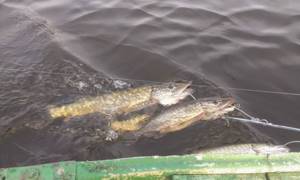
Most avid fishermen love fishing on Seliger precisely because of the pike perch. Fish are found in all lakes, but most often large concentrations are formed in the Slobodsky, Ostashkovsky and Kravotynsky reaches. Pike perch spends more time in deep depressions where the water is clear. Fish come to the surface while searching for food or spawning. With the onset of hunting, individuals swim into shallow water, but it is very difficult to catch them. Most often, pike perch weighing up to 900 g is caught. The length of such a fish is about 40 cm. A professional considers fishing successful if he catches a trophy pike perch weighing up to 8 kg from Seliger.
Important! Pike perch spawning begins in May. The fish swim in schools in shallow water, but are of little interest to food, which makes the process of catching them more difficult.
The most successful fishing in May on Seliger will bring a good catch of bream. Even in June, the fish swim in shallow water and can be caught from the shore. Bream lives throughout the entire water area of the lake. Fans come across specimens weighing up to 1.5 kg. Professionals associate fishing only with catching trophies weighing about 5 kg. From mid-summer, closer to autumn, you will have to swim in a boat to deep places for bream. Fish settle in holes and gather in schools.
Seliger's perch has several varieties. A youngling is considered a trophy. If you are thinking about organizing fishing on Seliger in 2019, you need to hunt for this perch where there are shallow bodies of water. The fingerling is cunning and difficult to catch. Usually you come across fish weighing up to 1.5 kg. Large perch rubs near the stones.
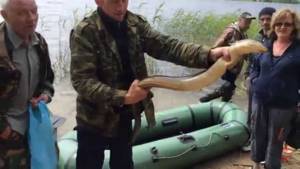
They don’t purposefully go after eels. It is better to catch it when relaxation and fishing on Seliger are combined into one event. Eels live where there is a lot of silt. Fish are able to move on land and stay out of water for up to 12 hours. Occasionally, night migrations occur. Flocks crawl overland into neighboring bodies of water. Eels are caught at night or early in the morning. For bait they use a worm and small fish.
In the 19th century, Seliger was famous for its large number of grayling. Fish were found in all parts of the lake. After mass fishing, the population decreased. Now only amateurs go fishing for grayling. Individuals weighing up to 1.5 kg are caught using a spinning rod. The habitat is small ponds. Grayling loves pools, places where trees have fallen into the water. The best time for fishing is July and October. At this time, the grayling begins to eat.

Pike can be found in any shallow water of Seliger, but the largest concentrations can be found in the Selizharovsky and Troitsky reaches, as well as the Polonovka River.

Seliger is rich in trout and peled. If you are hunting for this fish, the best fishing place is the Shchebirka River, as well as the Ostashkovsky Reach.
Interesting video of fishing on Seliger with spinning rods and fishing rods:
Fishing on Seliger
Everyone has long known that Seliger is a paradise for fishermen.
Due to its glacial origin, many lakes and depressions were formed. People have always been engaged in fishing on Seliger. In the 17th and 18th centuries, Seliger was considered the fishing center of Russia. Residents fished, knitted nets, built and sold boats. Currently, fishermen choose Seliger because of the wide variety of fish and the opportunity to fish in both winter and summer. Sit at dawn with a fishing rod on the pier. Listen to the cries of seagulls and ringing silence. It is here that you can catch your trophy and take a break from the noisy city. It's rare that vacationers leave without fish. This only happens due to a sudden change in weather. And so basically we constantly see the happiness of fishermen when they come to show off their catch. So, what can you catch in our reservoir? In Seliger, in the rivers and lakes associated with it, there are about 30 species of fish. First of all, these are bream, pike, pike perch, perch, roach.
Pike is the first in popularity and desire to catch. Pike loves a small current, next to a small backwater. This is exactly what we have. Large pike mostly stay at depths with an uneven bottom, rifts, and sharp changes in depth, while medium and small pike can most often be found near the abundant presence of grass, the edge of reeds at a depth of 0.5 - 2 meters. And as they say, a clear example of our catch is pike on a spinning rod - 5 kg, on a jig - 7 kg. Bream is one of the most popular fish. Almost every fisherman dreams of catching a huge bream. Of course, for this you need to know everything about him. Knowledgeable fishermen caught 3.5 kg of bream from us. You need to approach this thoroughly and come for a few days in order to have time to feed the fish. The pike perch on Seliger is large and strong. You can catch it at any time of the year. The best time starts from mid-October until freeze-up. To catch pike perch on Seliger, fishing and trolling are recommended. In June, on the river where there are deep banks or in places where there are a lot of snags, you can catch pike perch using small live bait; at this time it is difficult to catch it with artificial bait, because his activity subsides. We even caught 1 kg of pike perch on a donk. Perch is a popular target for fishermen on Seliger. The appearance of a perch is influenced by many factors, such as its habitat, the quality and color of the water, and even the bottom soil. In the lower kotyts they catch perch with a jig in the summer and with a spoon in the winter, even at 1 kg. Roach on Seliger are simply everywhere. You can fish from piers, rafts and boats. Caught with a worm or corn. There is a lot of it from small individuals up to 1 kg. Our fishermen and we personally caught roach up to 500g. Burbot - In the cold season, fishermen catch burbot on Seliger. It loves the cold and is active at water temperatures up to +10°C, so it is difficult to catch in the summer. The best time for fishing is cold weather. Burbot cannot be confused with other fish. We caught an individual weighing 3.1 kg, mainly on girders. Asp – the asp’s habitats are medium and large rivers with rapids and riffles. It winters in deep holes with a quiet current, and sometimes without any current at all. In the post-spawning period and in the fall, when the water gets colder, it selects sites with medium depth, weak or moderate currents for parking and sticks to the bottom. In summer, it spends most of the day in the upper layers of water. At night, and sometimes during the day, in inclement weather and when the water level rises sharply, it goes to nearby depths. We caught an asp weighing 3.2 kg.
Also found in large quantities are tench , crucian carp , carp and, less catfish . Although in the Selizharovka River itself, local fishermen often catch catfish up to 5 kg. The Selizharovsky reach, starting from the strait between the Upper and Lower Rudins and going to the southeast, among low green ridges, partly already looks not like a lake, but like a large calm river. It is not wide, long, and the flow of the Seliger waters gathered here from all reaches is clearly visible in it. Selizharovsky Reach serves as a kind of funnel through which the waters of the lake flow first into the Selizharovka River and then into the Volga. Several turns divide the Selizharovsky reach into three, as it were, separate small reaches - Verkhnerudinsky, Rogozhsky and Nizhnekotipky. They are all shallow. The greatest depths lie between the Upper and Lower Rudins (up to 9m). Further on, the depth in the middle of the reaches is no more than 5 m, and the channels between parts of the reach sometimes become so shallow and overgrown that even motor boats have difficulty passing here. In general, this reach, like Vesetsky, warms up well, blooms in summer and is covered with algae, and along the banks and at its southern end it is heavily overgrown with reeds. There is fish on Seliger, if only you would like to catch it!
What to fish with on Seliger
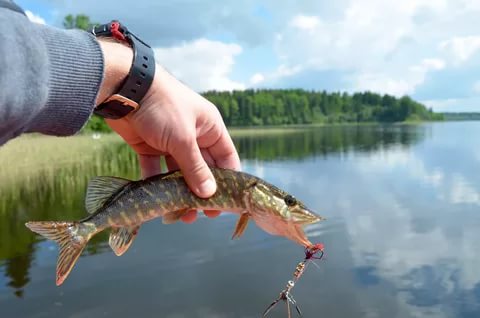
Choosing a fishing spot on Seliger is an important matter, but even the most successful determination of the accumulation of the desired type of fish does not guarantee a 100% catch. To get the desired result, you need to choose the right gear, bait, and groundbait.
It is best to catch pike with a spinning rod. Spinners use a rotating type: “Universal”, “Kemi”, “Baikal” and other similar models. Experienced fishermen recommend Canada spinners. In addition to pike, you can catch other predators with a spinning rod. For example, both pike and perch go well after the Trofimov spinner. However, there is one more trick. Perch like the color red. To catch a predator, bright hairs are attached to the spoon.
Pike are attracted by bait. An excellent bait is finely chopped fish scattered in the water. In addition to spinning, pike can be caught on Seliger using girders. The essence of the method is to place bait on a hook. A pole is stuck into the ground. The girder itself and a small plastic bottle with small bread crumbs are attached to it. The bottom of the bottle is pierced with a nail. From a container swaying in the wind, crackers pour out in portions and float through the water, attracting small fish. When the pike approaches, the fry swim away, and the predator remains with the bait of the pike.
It is good to feed perch, pike perch, burbot, and catfish with worms. They are thrown in large quantities, but first mixed generously with liquid clay. The worms will slowly work their way out of the clumps as they dissolve, attracting larger fish. Burbot is easy to lure with rotten meat. Use spoiled fish or meat as bait
Features of fishing on Seliger
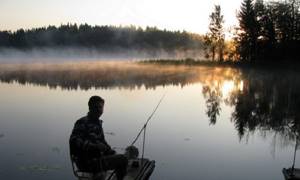
The peculiarity of fishing on Lake Seliger is that even a beginner can get a good catch. The lake contains almost all common fish species. Experienced fishermen can guide themselves, but for novice fishermen it is best to choose paid recreation centers. Firstly, there are houses for overnight stays. Secondly, experienced instructors work at the Seliger bases. Professionals will help you choose gear and recommend a place.
The advantage of Seliger's paid bases is the availability of feeding places. A person can immediately go fishing. However, there is a huge disadvantage here. Large fish are almost rarely found in well-fed areas.
Experienced amateurs who often fish on Seliger take bait, lures, and bait with them. Worms are in short supply here. They are difficult to even find in the ground. If you do not stock up on worms, you will have to buy them from the local population. Numerous advertisements indicate the sale, but this is again an unnecessary waste.
Seagulls help you find schools of pike perch, pike, and perch. Predators chase fry along Seliger. Seagulls are eager to catch fish jumping out of the water. If birds are circling in a flock over the water, it means there are fish there, and there will be good fishing here.
Winter fishing on Seliger
With the arrival of cold weather, people on Seliger engage in ice fishing. The bite of each type of fish is associated with the weather. Pike are caught during the thaw. When the frost gets stronger, bream and perch begin to be caught. Pike perch are often caught in winter. Areas where there are rifts, trees fallen into the water, and river confluences are chosen as places for winter fishing.
Advice! According to reviews, fishing on Seliger in 2021 in winter was best done in the cozy recreation center “Borovoye”. Its location is the coast of Peno Island. There are good discounts and heated houses here in winter.
Fishing on Seliger in summer
Summer fishing brings real pleasure combined with relaxation. June will delight you with an abundant catch of bream. The shallow waters are practically inhabited by schools. Bream is often caught in abundance even without bait.
In July it's pike time. Spinners chase fish all along the coast. Pike is capricious, which creates the excitement of fishing.
August is considered a period of quiet fishing, most often from a boat. Perch, roach and rudd are well caught. Fishermen place their own or rented gear around the lake. Those who love excitement can chase perch with a spinning rod.
September
This month is rich in pike, of which there are many in the lower part of the Volga. Look for this predatory fish in shallow places, particularly in thickets and large snags. But in the rainy and cold weather of autumn, pike prefer to stay in the depths, so in October-November you will not find them in shallow water. For fishing, tracks with large spoons and tackle with dead fry or small fish are suitable.
Perches, roaches and breams often stay in the coastal part of the reservoir, under a layer of fallen leaves. Fish can be caught with a spinning rod, lure, live bait, or fishing.
At the beginning of September, experienced fishermen rarely return from fishing with an empty backpack; almost all types of fish willingly take the offered bait. But burbot, on the contrary, bites more readily in October than in September.
Map of Lake Seliger for fishermen
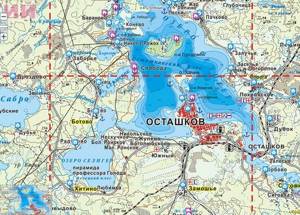
There are so-called online maps indicating the fishing spots of Seliger. However, they do not provide accurate information. Frequent changes occur in nature. This applies to the weather and the topography of the lake bottom. In addition, schools of fish migrate. Experienced anglers make their own maps while fishing and trust their eyes and research.
If we describe the bottom topography in general terms, then Seliger has an average depth of 5 m. There are large depressions up to 20 m deep. The main bottom sediments consist of silt, sand, and stone.

